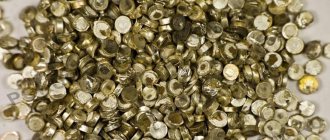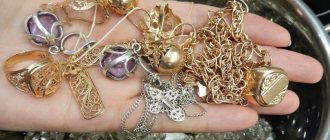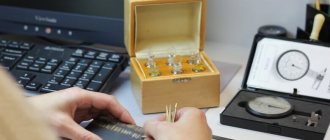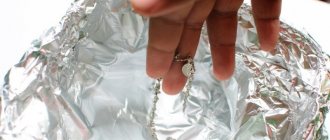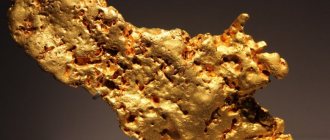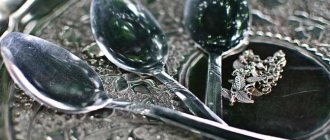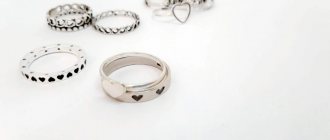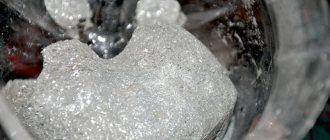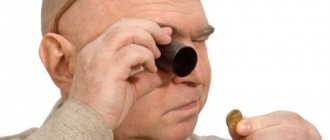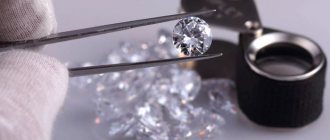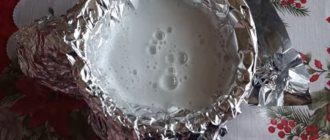- How to distinguish silver from other metals
Silver is an elegant and valuable metal. And like any valuable thing, silver has counterfeits. Although it is counterfeited much less frequently than other precious metals, such cases still exist and there is no point in denying them. It is better to learn to determine what is in front of you - fake or not. This way you can avoid buying a low-quality product, and at the same time you can check your own silver for authenticity.
Below we describe how you can check the authenticity of silver yourself at home or directly at a jewelry store.
Stamp and hallmark
Products made from pure silver are visually beautiful, but are not practical. Due to the increased ductility of the metal, the product quickly ceases to shine in the absence of constant cleaning.
In the jewelry industry, alloys of various metals have long been used to increase the strength of products. To distinguish by the amount of additives added, a sample is applied to the jewelry.
An example of a sample on a silver ring.
A test (a stamp showing the content of impurities in silver) is placed on the inside of the product. Fineness - three numbers indicating the silver content in one kilogram of the alloy. For example, standard 925 means that 1 kg contains 75 grams of impurities and 925 grams of pure metal.
Samples of silver items:
| Try | Characteristics |
| 720 | Low standard silver, copper impurity. The most durable silver alloy used in industrial applications. Jewelry is not made from such silver, so it is inappropriate to undergo an assay inspection here. |
| 800, 830 | Production of silver cutlery. |
| 875 | “White gold” - contains no gold. Only silver and copper. |
| 916 | The alloy of this hallmark was used in the Soviet Union in the manufacture of silverware (not currently used in the jewelry industry). |
| 925 | Silver jewelry. |
| 960 | An alloy close to natural metal, soft and easily deformable (used to create relief compositions). |
| 999 | Pure silver, it is used to create collectible coins and bars (used in medicine and industry). |
Hydrostatic weighing
The easiest way to determine the authenticity of a product is to determine the density of the material. To do this, you need to first weigh the dry coin. Then pour water into the glass, reset the scales and determine the “wet” weight of the coin. Now we divide the “dry” weight by the difference in two dimensions, and if the resulting number is in the region of 10.5, then this is real silver, since the metals used for fakes do not have a similar density.
You can try using a digital food scale at home, but to determine the authenticity of a coin or jewelry, its accuracy must be quite high.
Iodine
A drop of iodine and the product being tested are required. Iodine reacts chemically with silver. The process is accompanied by darkening at the point of contact between iodine and silver. The mark from a reaction to iodine is very difficult to remove, so the method is not very good. It is better to conduct the experiment on the inside of the object.
Reaction of silver to iodine.
- A drop of iodine on real silver will leave a dark stain.
- Iodine does not react with other metals. The surface where iodine was applied will remain unchanged.
Iodine stains are difficult to remove! Be careful, check from the inside of the products.
At home, it is not possible to determine the sample and silver-plated products. Aluminum and copper blanks coated with a thin layer of silver are often found. Iodine will leave a mark on such products, but the silver content cannot be determined in this way.
Testing with iodine is one of the effective methods for identifying fake silver at home. The remaining methods are more suitable for self-soothing or are less accessible for self-checking.
How to check in the store when purchasing
The store does not allow the use of any chemicals or improvised tools.
How can the seller verify the authenticity of the silver?
The analysis is carried out by appearance and hearing.
See if there is a dark mark left on the skin after prolonged rubbing. You can drop the decoration and listen to the sound (suitable for hollow structures). Before going to a dubious store, take a magnet with you and check whether the jewelry is magnetic. And, of course, look at the sample and stamp.
Information on the tag
All jewelry must be sold with tags. The exception is those to which it cannot be attached (piercing).
The label indicates all the characteristics of the product, including weight, dimensions, sample and material of manufacture.
If the material used is another silver-plated alloy, this must also be indicated on the tag.
Store tests for silver (chrompic)
You can purchase a test to check metal in pharmacies or special retail outlets.
To use the reagent correctly, read the instructions and carry out simple manipulations. Before starting the experiment, you should wipe the selected area with a file or run the product over a stone made of silicon slate (so as not to spoil the appearance of the product) and treat it with a reagent. After a certain period of time, you can assess the condition of the metal by the color of the developed trace:
A drop of a special tester turned red - real silver (right). Has not changed color - fake.
Handy reagents
If you have no desire to listen, sniff and look closely, then the authenticity of silver can be determined using bleach, sulfuric acid or iodine. To do this, use a cotton swab to place a barely noticeable spot on the product and monitor its reaction. Has the product started to darken around the perimeter of the stain? Then in front of you is a silver or at least silver-plated item. No? Then there is no smell of silver here.
Advice
You can also check the authenticity without fear of spoiling the item by rubbing it with chalk. In this case, upon contact with silver, the chalk should turn black.
Sulfur ointment, nitric acid, whiteness
The principle of testing is the same as when testing with iodine. We apply a drop of the reagent to the product, wait and see if the product reacts to the drugs:
- A real silver item will show tarnish where the substances were applied.
- Nothing will happen on a fake.
Reaction to chemical exposure.
Authentication
Situations vary. Someone buys silver jewelry. Others inherit a set of jewelry and cutlery. Some even manage to find interesting products.
The question is how to distinguish a silver coin from a fake, or to verify the authenticity of a cutlery set, rings, chains and other items made of precious metal.
Yes, counterfeit silver coins are often passed off as some kind of relics or objects of historical value. They are bought and sold.
Therefore, you need to know how to distinguish silver from counterfeit when purchasing. You already know about gold. Now it’s the turn of the less expensive, but also popular metal.
There are several ways to check a piece of jewelry or tableware:
- eyes and hands;
- iodine;
- magnet;
- vinegar;
- lapis pencil;
- sulfur ointment;
- bleach;
- nitric acid.
Now about each method separately, as well as in more detail.
Eyes and hands
Fake silver items resemble real items. A quick inspection may not notice the difference. But this is real:
- Look carefully
. Rub the product with your fingers for a minute. Are your hands clean? If there is a dark coating, then it is a fake. All because of the zinc that is added to the alloy. High zinc content leads to the appearance of dark marks on the hands; - Listen
. If they are coins, hit each other. Or on a hard surface. The original is always sonorous and bright. Copies sound dull; - Feel it
. Silver has good thermal conductivity. You can simply hold the product in your fist and hold it. The genuine product will heat up quickly.
These are the basic verification methods.
Iodine to the rescue
One drop of iodine. No, it doesn't kill the horse. We're not talking about nicotine. Iodine can be used to detect counterfeit silver.
Apply the liquid to the item. Does the contact area darken quickly? This is a sign of authenticity. If a white coating appears or there is no reaction, you have a fake.
Just remember. Iodine leaves traces on high-quality precious metal products. The only way to remove it is by sanding. Test from the invisible, inside side.
Take a magnet
A good assistant in identifying fakes as well as original products.
Any magnet will do. Even from a souvenir on the refrigerator.
Natural noble metal will not be magnetic. If it attracts, then it is a counterfeit.
The method does not provide a 100% guarantee. A parody of silver is made from aluminum, as well as cupronickel. But these metals are not magnetic.
Pour vinegar
Ordinary table vinegar, which is found in any kitchen, will help reveal the deception.
You need to take a suitable container and pour vinegar into it. Then place the product in the glass.
Nothing will happen to natural silver. If any reaction occurs, then it is fake.
How can a lapis pencil and chalk help?
Perfect solution. An old, but proven and effective method.
The sequence is:
- visit the nearest pharmacy and buy lapis;
- the product costs about 100 rubles, but is enough for a number of checks, plus for its intended purpose;
- moisten a lapis pencil in clean water;
- sweep over the surface of the silver;
- on fakes there is a black stripe.
If there is no trace, then this is a quality product.
The second option is chalk. Also a simple verification method. But the efficiency is also up to par. You need regular school chalk. The product is rubbed with it. If traces of a dark color remain on the chalk, then this is the original.
Sulfuric ointment
The testing principle is the same as when using iodine.
You need to apply a little ointment to the potentially silver surface. Leave for approximately 30-60 minutes.
If after this the object becomes dark, then the silver is genuine.
The advantage of sulfur ointment compared to iodine is that it is easier to remove a dark stain from the ointment. It is enough to take ammonia or soda. Wipe with a napkin or cotton sponge.
Bleach to the rescue
Bleach contains chlorine. Natural silver reacts with such a substance. Therefore, good quality jewelry will darken.
But try not to use bleach when testing earrings or chains.
Application of nitric acid
You can find it in almost every pharmacy.
A quick and clear authentication test.
If after application the product turns black, then the silver is real. If there is a different reaction, or no reaction, it is a copy.
But in the case of nitric acid, it is important to adhere to safety rules. Work only with gloves.
Magnet
You can check silver at home without any marks on the metal. A regular magnet is used for this. The reaction to the magnet will indicate a fake:
Magnetic testing - detection of gross fakes.
- A product made of real silver does not attach to a magnet.
- Fake ferrous metals will stick to the magnet.
Do not check chain locks with a magnet. The locks have a mechanism that responds to a magnet.
The method is very popular, but not very accurate; non-ferrous metals do not always react to a magnet.
Internet or numismatic reference books
An excellent way for numismatists is to compare the weight of the coin in the directory with the actual weight of the product offered for purchase. Due to the difference in density, it is very easy to identify a coin made from other metals, even if it is silvered and looks exactly like the real thing.
Scales for hydrostatic weighing 1 - mesh (perforated) glass; 2 - vessel with drain for water; 3 - a glass with shot to balance the mass of the mesh glass in the water; 4 - weights
Thermal method
One of the properties of silver is thermal conductivity, due to which the metal quickly heats up to ambient temperature. If you hold the product in your hand, it will almost immediately heat up to body temperature. When immersed in cold or hot water, the metal will quickly return to the same temperature.
Boiling water is a good way to test the quality of a silver alloy. When removed from a hot product, it burns the skin and quickly cools to room temperature. Fake silver removed from boiling water will be lukewarm.
Temperature
Taking a silver spoon in your hands, you will feel that the product very quickly acquired the temperature of your body. This is due to the high thermal conductivity of silver, which makes counterfeits made from other metals remain cool for a suspiciously long time.
Advice
You can also go the opposite way and put, for example, an ice cube on a coin or tray. If it melts abnormally quickly, then this is real silver; if not, it is better to refrain from buying.
How to distinguish silver from cupronickel
- A silver product contains a hallmark; a mark with the MNC symbols means cupronickel.
A distinctive feature of cupronickel cutlery. - Cupronickel can be recognized using ordinary water. You should pour it into a container and place the product there. After a short period of time, greenery will appear on things made from cupronickel, but silver will not change its shade.
- Cupronickel can be identified by its smell; it is characterized by the usual smell of copper. To make the aroma stronger, you can rub the object of study.
- You can run a lapis pencil over the moistened surface of the object. A silver product will not show a reaction, but a dark spot will appear on cupronickel. If there is a suspicion that cupronickel is covered with a thin silver layer, you need to find the worn place and repeat the manipulations.
- Items made of cupronickel weigh much lighter than silver ones.
- Metal can be tested using iodine. A drop of the substance on an item placed in sunlight will show a dark spot on the silver. The trace is extremely difficult to remove, so you need to find an inconspicuous place for the experiment.
- One of the surest options would be to take the product to a jewelry workshop, where they will determine exactly what it is made of.
Vinegar
You can test silver with vinegar.
Pour the 9% table bite solution into a bowl and lower the product into the container for a few seconds. Since silver is a low-reactive metal, it will not react with vinegar. If a white coating appears on the product or other changes occur, this is a fake.
You can use a bite to clean silverware and dishes until they shine.
Video
How silver is determined for authenticity, how the sample is recognized in jewelry workshops. How to use special chemical liquids and analyzer:
Large video test of various metal products (aluminum, copper, chrome, stainless steel, silver) for the reaction of sulfur ointment. How to test silver at home video:
To protect yourself from purchasing a fake, it is better to purchase silver jewelry in jewelry stores. Here, upon request, the seller is obliged to present certificates of product quality. The likelihood of purchasing low-quality silver will be minimal.
Professional Silver Testing Methods
The most reliable way to understand whether silver is at your disposal or not is to contact a specialist. Home express diagnostics can lead not only to damage to the product, but also to household injuries. For example, when handling chemicals carelessly. Some people try to determine if the silver is real by looking at the tooth. Under no circumstances should you do this.
Any silver jewelry will be checked for authenticity in pawn shops, purchase shops, and jewelry workshops. Moreover, some companies provide this service free of charge. To do this, professional appraisers have special precious metal analyzers, reagents, touchstones and other tools.
That is, there is no point in checking it yourself, risking the integrity of the product.
Chemical test
If you are no stranger to chemistry, purchase a chemical test for the authenticity of silver. This is one of the most accurate ways to determine the quality of the substrate of a silver-plated product. For the test, you either need to make a fairly deep scratch on an inconspicuous area of the piece, or rub the piece against a touchstone. Now we drop acid onto the mark on the stone or the substrate in the scratch and look at the color: the brighter the shade of red, the purer the silver. Thus, a light brown color indicates silver of the 800th standard, and green – already of the 500th. The remaining colors will be given by the most popular metals for silver plating: yellow corresponds to tin or lead, dark brown to brass, and blue to nickel. Now you can be sure of the composition of the product not only on the surface, but also inside.
We recommend: How to chop greens easier and better: chop or trim with scissors
As you can see, it is not necessary to bend or saw a silver spoon to determine its authenticity, even if you do not find a hallmark. Use these tips and you will greatly reduce the chance of running into a fake.
Method for determining a sample at home
There are not always special devices or substances at hand. But some reagents are still available to the public, and not just to laboratory workers.
What is Chrompeak
Chrompic is a chemical often used by jewelers to evaluate the quality of an alloy. Prepared:
- gloves;
- pipette;
- sewing needle;
- tweezers.
Instructions that allow you to quickly recognize a fake or, conversely, verify the authenticity of an item:
- Notches are made on the product using a nail file.
- Chrompik is applied.
- Observe the reaction. If there is Ag in the material, the object will turn red. Other shades indicate counterfeit jewelry or the use of another precious metal.
Chrome pick for silver
Table: sample and color ratio
When using a homemade reagent, changes can be seen within 5-10 minutes. If you are wondering how to recognize silver, the relationship between the combination of alloy and the color of the alloy will help you figure it out:
| Hue | Metal |
| Rich brown | Brass |
| Yellow | Sn, Pb |
| Bluish | Ni |
| Green | Ag alloy fineness less than 800 |
| Brown | Metal 800 |
| Rich red | Popular sample 925 |
| Bright red | Pure Ag |
Blackened silver
Blackening is a type of metal coating that is achieved by melting lead, copper and silver sulfide oxides. The niello, spreading over the surface of the product, colors it black and creates patterns. Not a single blackened decoration is similar to another. Blackening also increases the durability of the product, because it does not require cleaning.
There is also a metal coating method called oxidation. Externally, it is very similar to blackening. But the blackening process is more complex and the resulting product is more expensive.
Oxidation is the use of potassium sulfide, which causes corrosion or darkening of the surface of the jewelry.
Blackening is a more complex process, in which, in addition to silver, copper and lead are also used. An alloy is melted into the cut out parts of the jewelry, which creates an additional layer on the product.
Oxidation is a less energy-consuming and expensive process compared to blackening.
Silver is silver, but what kind?
There is a category of people for whom the age and origin of a product is much more important than the chemical composition - these are numismatists, collectors and antique dealers. And while experienced people can spot a fake “offhand,” a beginner can spend a lot of money on a remake.
Counterfeit coin that failed the test
A careful study of the catalogs will help you avoid disappointment - everything of any significance is described in detail in them. The above recognition methods will also not be superfluous. Although numismatists have their own specifics - for example, having discovered an 18th century coin made of the purest noble metal, they will be disappointed: at that time money was minted from low-grade alloys, which means the find is not genuine.
Technical silver
Hearing the word “technical” in the name, one may mistakenly assume that this is a low-quality metal that is not used for the manufacture of something important. However, this is not at all true. It is this type of metal that has the purest alloy. The share of impurities here is only 0.1%, the remaining 99.9% is pure argentum.
Accordingly, technical silver has the highest standard of 999. Technical silver faces serious challenges. It is used for the manufacture of wires, contacts, radio components, and auto parts. Among other varieties, it is characterized by high electrical conductivity and light reflection.
Despite its value and high quality, such silver cannot be worn on the body. It sometimes contains impurities of nickel, lead, tin, aluminum or copper. Nickel is a strong allergen. Lead tends to accumulate in the body and cause harm over time. Other impurities are safe.
Radiant silver
Radiated silver is a metal coated with radium. Not to be confused with rhodium plating. This is rhodium plated. These two consonant names of Argentum species have a large number of differences. The fact is that radium is a radioactive chemical element and is contraindicated for use in jewelry. This is a highly toxic element that can harm the human body.
The discovery of radium by Pierre and Marie Curie played an important role in history. Today radium is used in the fight against malignant tumors. Radon baths help in the treatment of diseases of the musculoskeletal system. The word radium is of Latin origin “radius” and means ray. When combined with other substances, radium is capable of producing light. Therefore, it is widely used in the manufacture of paints for road markings or runways. Radium, like silver, is widely used in the technical and medical fields. Until the 60-70s of the last century, silver parts coated with radium were widely used in watches, compasses, aircraft instruments, and instruments for physical measurements.
